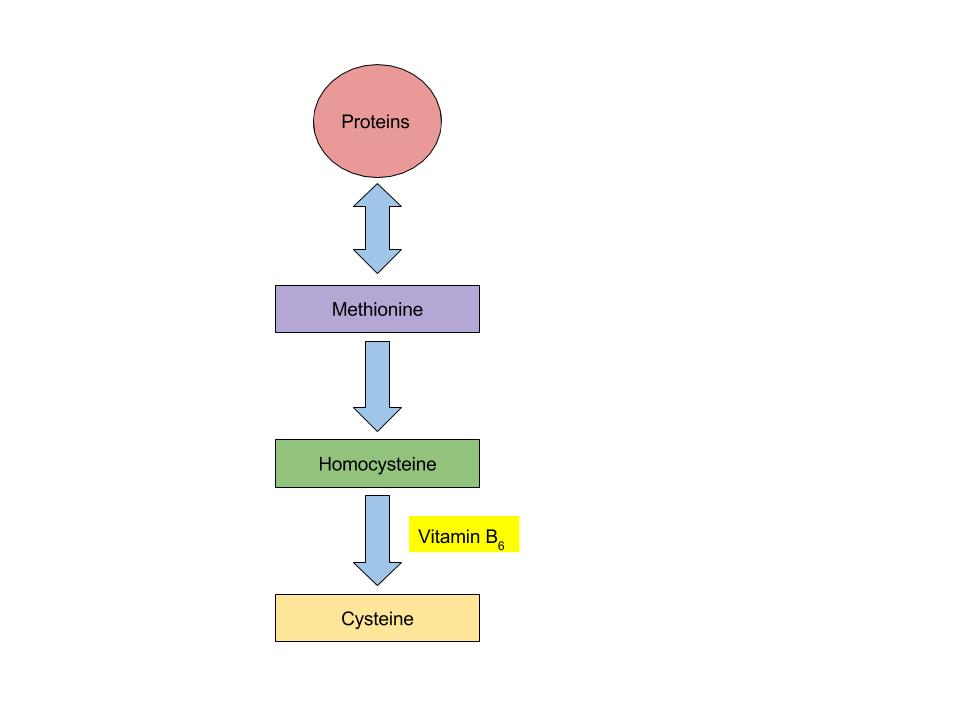Chapter 11: Micronutrients in Metabolism
11.5 Vitamin B6
University of Hawai‘i at Mānoa Food Science and Human Nutrition Program
Vitamin B6 (Pyridoxine)
Vitamin B6 is the coenzyme involved in a wide variety of functions in the body. One major function is the nitrogen transfer between amino acids which plays a role in amino acid synthesis and catabolism. Also, it functions to release glucose from glycogen in the catabolic pathway of glycogenolysis and is required by enzymes for the synthesis of multiple neurotransmitters and hemoglobin (Figure 11.51 “The Function of Vitamin B6 in Amino Acid Metabolism”).
Vitamin B6 is also a required coenzyme for the synthesis of hemoglobin. A deficiency in vitamin B6 can cause anemia, but it is of a different type than that caused by insufficient folate, cobalamin, or iron; although the symptoms are similar. The size of red blood cells is normal or somewhat smaller but the hemoglobin content is lower. This means each red blood cell has less capacity for carrying oxygen, resulting in muscle weakness, fatigue, and shortness of breath. Other deficiency symptoms of vitamin B6 can cause dermatitis, mouth sores, and confusion.

The vitamin B6 coenzyme is needed for a number of different reactions that are essential for amino acid synthesis, catabolism for energy, and the synthesis of glucose and neurotransmitters.

Vitamin B6 coenzyme is essential for the conversion of amino acid methionine into cysteine. With low levels of Vitamin B6, homocysteine will build up in the blood. High levels of homocysteine increases the risk for heart disease.
Vitamin B6 Toxicity
Currently, there are no adverse effects that have been associated with a high dietary intake of vitamin B6, but large supplemental doses can cause severe nerve impairment. To prevent this from occurring, the UL for adults is set at 100 mg/day.
Dietary Reference Intakes
The RDAs and ULs for different age groups for vitamin B6 are listed in Table 11.51 “Dietary Reference Intakes for Vitamin B6“.
Table 11.51 Dietary Reference Intakes for Vitamin B6[1]
| Age Group | RDA Males and Females mg/day | UL |
| Infants (0–6 months) | 0.1* | Not possible to determine |
| Infants (7–12 months) | 0.3* | Not possible to determine |
| Children (1–3 years) | 0.5 | 30 |
| Children (4–8 years) | 0.6 | 40 |
| Children (9–13 years) | 1 | 60 |
| Adolescents (14–18 years) | 1.3 (males), 1.2 (females) | 80 |
| Adults (19-50 years) | 1.3 | 100 |
| Adults (>51 years) | 1.7 (males), 1.5 (females) | 100 |
| Pregnancy | 1.9 | Same as non-pregnant |
| Lactation | 2.0 | Same as non-lactating |
| *denotes Adequate Intake | ||
Dietary Sources
Vitamin B6 can be found in a variety of foods. The richest sources include fish, beef liver and other organ meats, potatoes, and other starchy vegetables and fruits. For the Vitamin B6 content of various foods, see Table 11.52 Vitamin B6 Content of Various Foods”.
Table 11.52 Vitamin B6 Content of Various Foods[2]
| Food | Serving | Vitamin B6 (mg) | Percent Daily Value |
| Chickpeas | 1 c. | 1.1 | 55 |
| Tuna, fresh | 3 oz. | 0.9 | 45 |
| Salmon | 3 oz. | 0.6 | 30 |
| Potatoes | 1 c. | 0.4 | 20 |
| Banana | 1 medium | 0.4 | 20 |
| Ground beef patty | 3 oz. | 0.3 | 10 |
| White rice, enriched | 1 c. | 0.1 | 5 |
| Spinach | ½ c | 0.1 | 5 |
- Dietary Fact Sheet for Health Professionals: Vitamin B6. National Institute of Health, Office of Dietary Supplements. https://ods.od.nih.gov/factsheets/VitaminB6-HealthProfessional/. Updated June 16, 2023. Accessed August 2, 2023. ↵
- Ibid. ↵
Amino acids are the building blocks of proteins, simple subunits composed of carbon, oxygen, hydrogen, and nitrogen.
Catabolism refers to catabolic metabolic pathways. Catabolic pathways break down polymers into their monomers, releasing energy
Hemoglobin is the oxygen-carrying protein within red blood cells.
Anemia is when a person's ability to carry oxygen throughout the body is lowered, due to a lack of red blood cells and/or hemoglobin.
“heart disease” refers to several types of heart conditions. The most common type is coronary artery disease, which can cause a heart attack. Other kinds of heart disease may involve the valves in the heart, or the heart may not pump well and cause heart failure.

